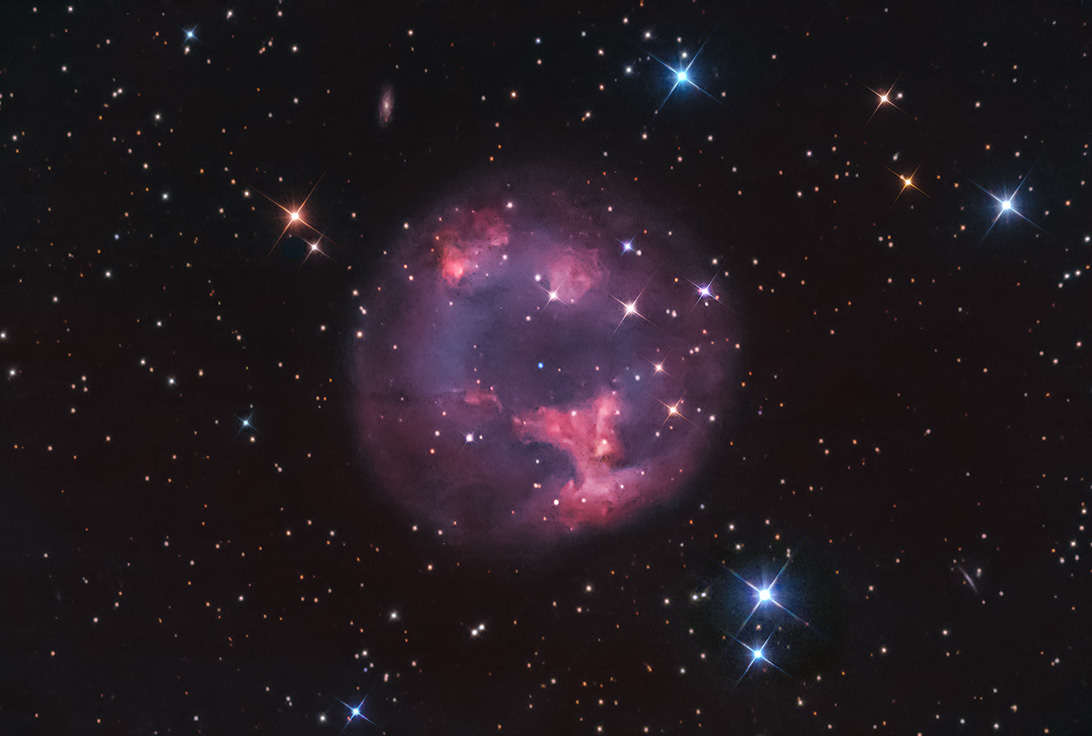Abell 7
Image Credit: Ron DiIulio & Donald Waid - Image Date: February, 2022
Equipment: 16 in. RC Telescope - ASI6200 Camera - Paramount-ME Mount
Abell 7 - Planetary Nebula in Lepus 1
Located in the constellation of Lepus approximately 1,800 light years distant is the faint planetary nebula cataloged Abell 7. Research by Tweedy and Kwitter (Astron.J. Supp. Series, 107, 255-262, 199) reference Abell 7 as the largest observed planetary nebula not reacting with interstellar medium. The central white dwarf star, designed WD 0500-1156 may actually be a member of a binary star system. (De Marco, et al., 2012)
Although Abell 7 is very faint, narrowband filters, along with long exposure image frames, were used in order to enhance contrast and brightness of the object during processing. This resulted in bringing out the internal features and structure of this remarkable and complex planetary nebula.
The displayed image was processed as a bi-color image with Hydrogen Alpha data mapped to the red channel and Oxygen III data mapped to the green and blue channels. The stars were overlaid with data obtained from a separate RGB filtered image. This technique yields a near true color image.
This image of Abell 7 was selecteded for publication as NASA's May 21, 2022 Astronomy Picture of the Day (APOD).
Image Credit: Ron DiIulio & Donald Waid - Image Date: February, 2022
Equipment: 16 in. RC Telescope - ASI6200 Camera - Paramount-ME Mount
Abell 7 - Planetary Nebula in Lepus 1
Located in the constellation of Lepus approximately 1,800 light years distant is the faint planetary nebula cataloged Abell 7. Research by Tweedy and Kwitter (Astron.J. Supp. Series, 107, 255-262, 199) reference Abell 7 as the largest observed planetary nebula not reacting with interstellar medium. The central white dwarf star, designed WD 0500-1156 may actually be a member of a binary star system. (De Marco, et al., 2012)
Although Abell 7 is very faint, narrowband filters, along with long exposure image frames, were used in order to enhance contrast and brightness of the object during processing. This resulted in bringing out the internal features and structure of this remarkable and complex planetary nebula.
The displayed image was processed as a bi-color image with Hydrogen Alpha data mapped to the red channel and Oxygen III data mapped to the green and blue channels. The stars were overlaid with data obtained from a separate RGB filtered image. This technique yields a near true color image.
This image of Abell 7 was selecteded for publication as NASA's May 21, 2022 Astronomy Picture of the Day (APOD).
Although Abell 7 is very faint, narrowband filters, along with long exposure image frames, were used in order to enhance contrast and brightness of the object during processing. This resulted in bringing out the internal features and structure of this remarkable and complex planetary nebula.
The displayed image was processed as a bi-color image with Hydrogen Alpha data mapped to the red channel and Oxygen III data mapped to the green and blue channels. The stars were overlaid with data obtained from a separate RGB filtered image. This technique yields a near true color image.
This image of Abell 7 was selecteded for publication as NASA's May 21, 2022 Astronomy Picture of the Day (APOD).
Located in the constellation of Lepus approximately 1,800 light years distant is the faint planetary nebula cataloged Abell 7. Research by Tweedy and Kwitter (Astron.J. Supp. Series, 107, 255-262, 199) reference Abell 7 as the largest observed planetary nebula not reacting with interstellar medium. The central white dwarf star, designed WD 0500-1156 may actually be a member of a binary star system. (De Marco, et al., 2012)
